通往萨卡洛布拉湾的路,西班牙马约卡岛 The road leading to Sa Calobra on the Spanish Balearic island of Majorca (© Tolo Balaguer/agefotostock)
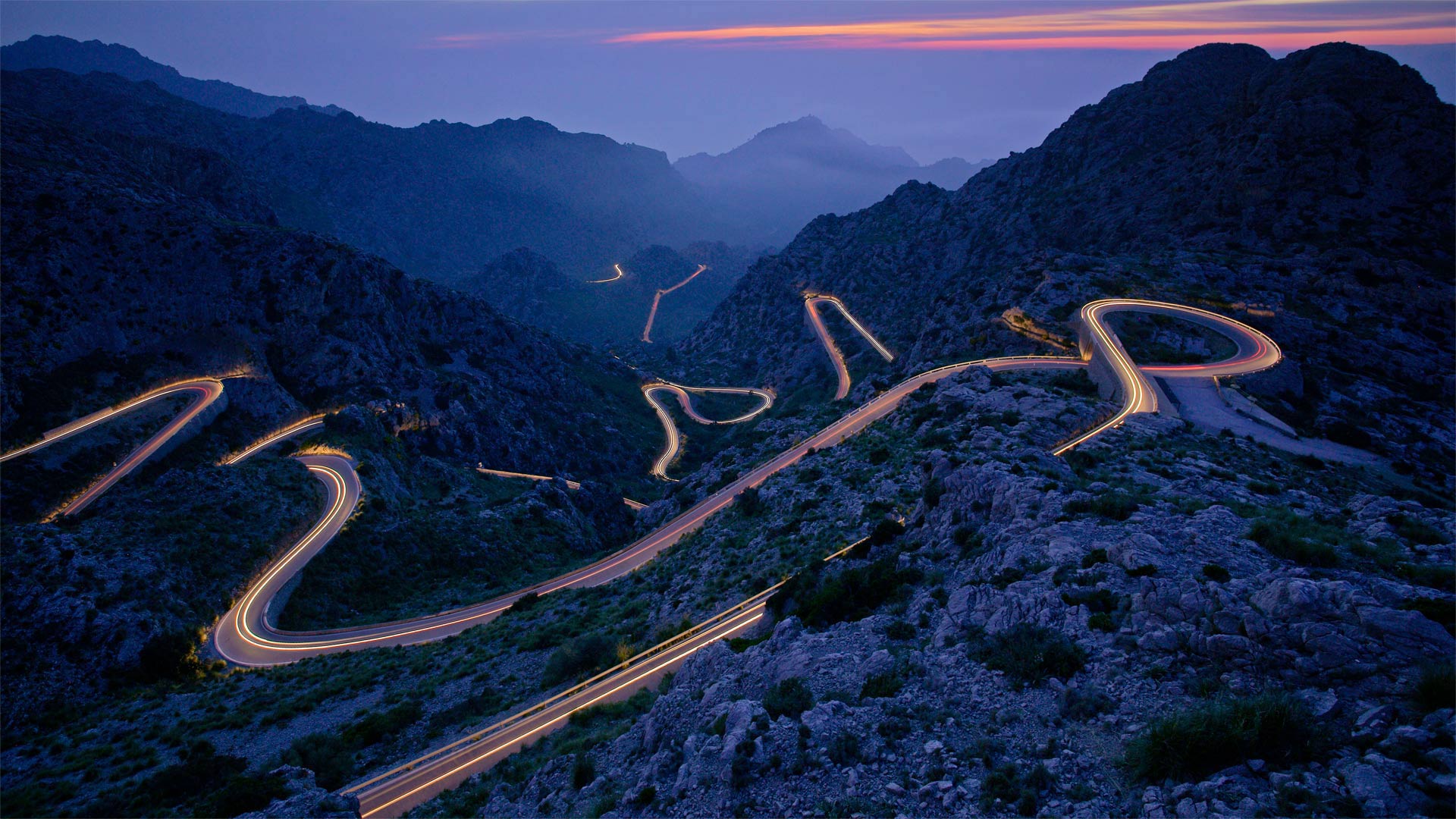
通往萨卡洛布拉湾的路,西班牙马约卡岛 The road leading to Sa Calobra on the Spanish Balearic island of Majorca (© Tolo Balaguer/agefotostock)
Road to Sa Calobra, Majorca, Spain
Though twists and turns abound on this road leading to Sa Calobra, on the Spanish island of Majorca, you'd have a hard time getting lost out here—there's only one road in and out of this coastal town. Rather than cut a more direct path through the mountains via tunnels, the road's designer chose to incorporate numerous switchbacks and hairpin turns, allowing sightseers to journey above ground. After all, if you make the long trip to this Mediterranean island paradise, you won't want to miss a thing—just keep an eye on the road too!
通往西班牙马略卡岛萨卡罗布拉的道路
虽然这条通往西班牙马略卡岛萨卡洛布拉的道路上有很多曲折,但你在这里很难迷路,因为进出这个海滨小镇只有一条路。这条路的设计者并没有通过隧道开辟一条更为直接的山路,而是选择了大量的转弯和发夹式转弯,让观光者可以在地面上旅行。毕竟,如果你长途跋涉来到这个地中海岛屿天堂,你不会想错过任何东西的,只要留意一下路就好了!
坎塔布里亚的小教堂,西班牙 The chapel and hermitage of Santa Justa in Cantabria, Spain (© Luis Miguel Martin/Getty Images)
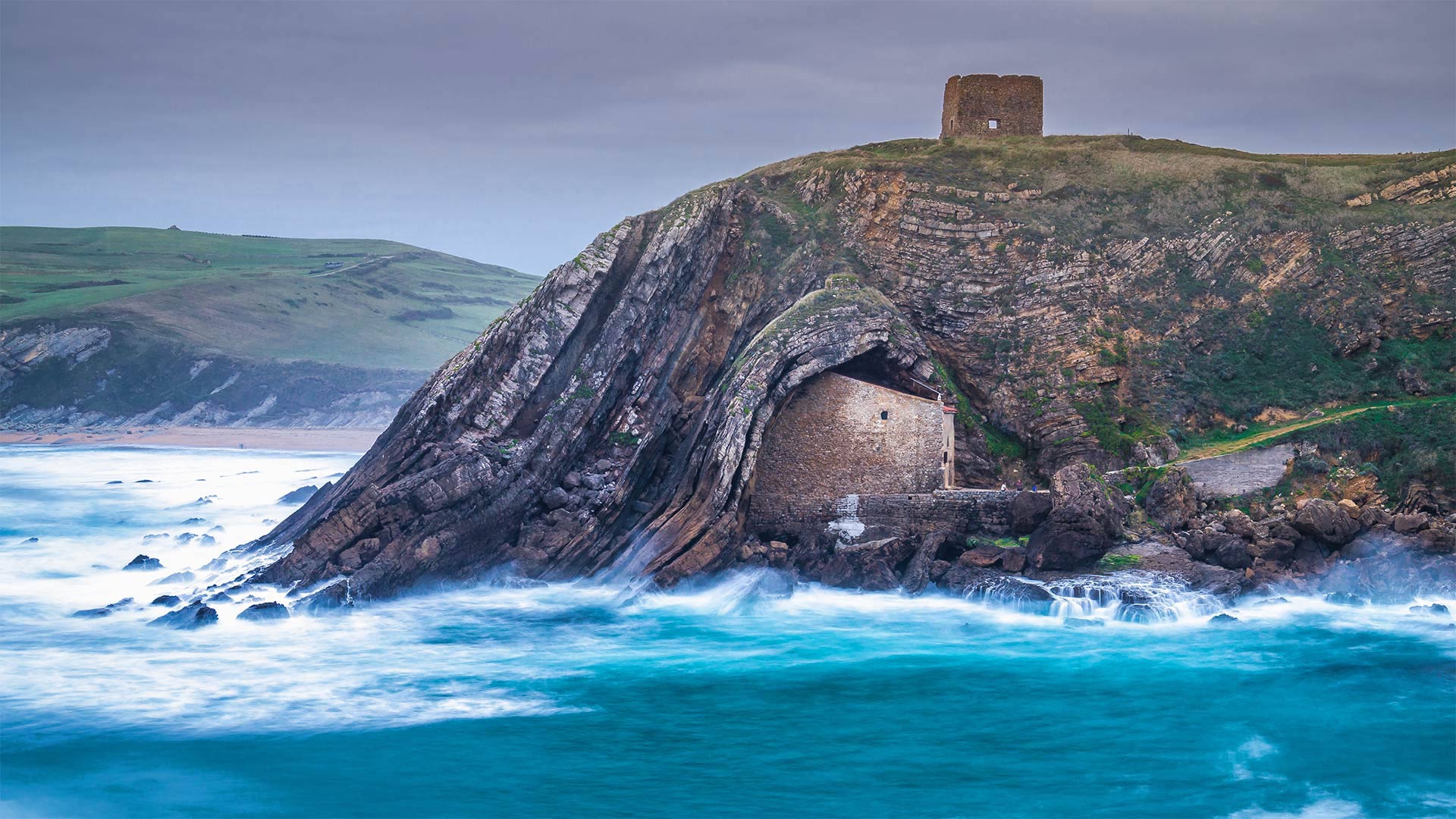
坎塔布里亚的小教堂,西班牙 The chapel and hermitage of Santa Justa in Cantabria, Spain (© Luis Miguel Martin/Getty Images)
The Hermitage of Santa Justa
Today's image brings us to Cantabria, a rugged region on the north coast of Spain. To reach this isolated stone hut, you'll need to wait until the frothing waters of the Bay of Biscay hit low tide, then traverse a silty path to the structure's façade. Peering in the windows, you'll see a cavernous room adorned with shrines—the long-abandoned living quarters of a religious hermit who dwelt here in the 8th century. Not your typical waterfront condo, but hey, it's cozy.
圣胡斯塔的隐居地
今天的图片带我们来到坎塔布里亚,一个位于西班牙北海岸的崎岖地区。要到达这座孤零零的石头小屋,你需要等到比斯开湾的泡沫水达到低潮,然后穿过一条粉土小路到达建筑物的正面。从窗户往里看,你会看到一个洞穴般的房间,里面装饰着神龛——一位8世纪居住在这里的宗教隐士长期被遗弃的居住区。这不是你典型的海滨公寓,但它很舒适。
别致的柳条田野,西班牙 Cañamares Wicker fields in Cañamares, Spain (© David Santiago Garcia/Alamy)
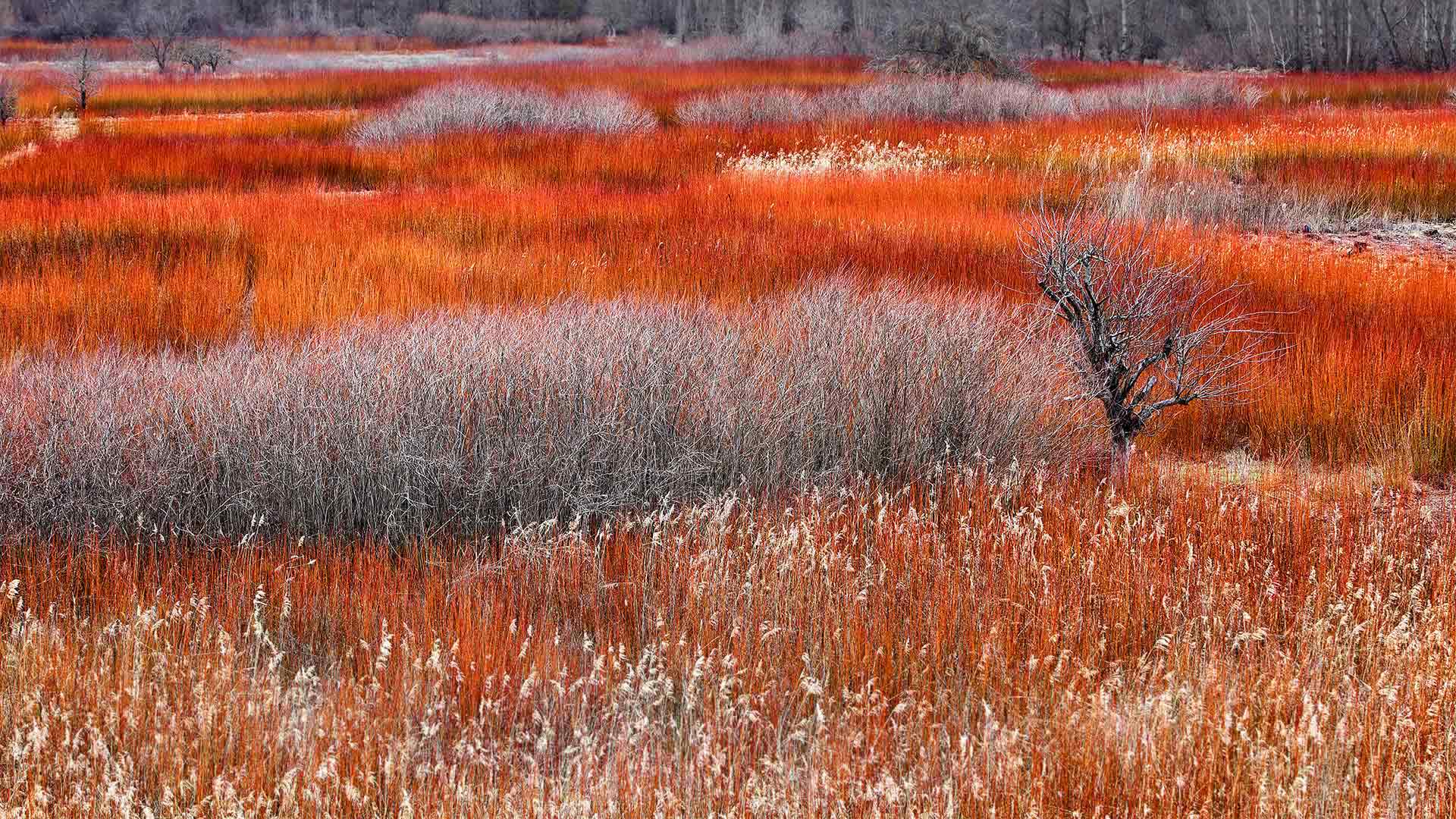
别致的柳条田野,西班牙 Cañamares Wicker fields in Cañamares, Spain (© David Santiago Garcia/Alamy)
Wicker fields in Cañamares, Spain
The summer swaths of green in this field have transformed by wintertime to a harvest-ready red—but it's not a harvest you can eat. Just what's being grown here?
Soon these reeds will be cut, bundled, and cured to become wicker. The blood-hued brush growing naturally by riverbanks near the central Spanish village of Cañamares is gathered each year by locals. The people of Cañamares maintain a centuries-old tradition of weaving with their locally harvested wicker. They create baskets, furniture, sculptures, and more from the coveted stalks.
西班牙卡尼亚马雷斯的柳条田
到了冬天,这片土地上的夏季大片绿色已经变成了可以收割的红色,但这不是你可以吃的收成。这里种的是什么?
很快,这些芦苇将被切割、捆扎并固化成柳条。每年当地人都会在靠近西班牙中部村庄卡尼亚马雷斯的河岸边采集这种自然生长的血色灌木。卡尼阿马尔人保持着用当地收获的柳条织布的悠久传统。他们用令人垂涎的秸秆制作篮子、家具、雕塑等。
鸟瞰埃尔塔霍峡谷, 西班牙龙达小镇 Aerial view of El Tajo gorge and the Puente Nuevo bridge in Ronda, Málaga, Spain (© Jude Newkirk/Amazing Aerial Agency)
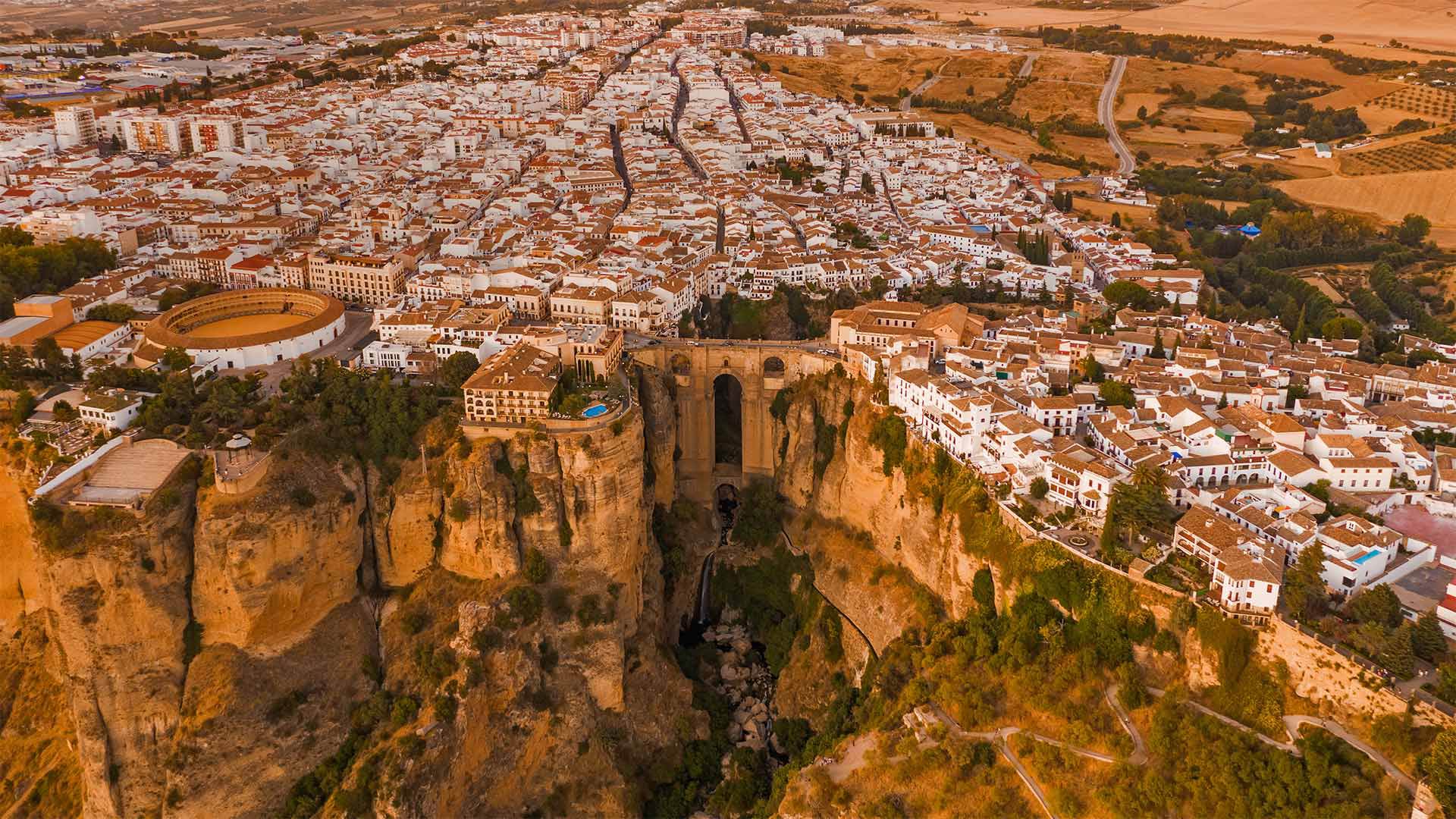
鸟瞰埃尔塔霍峡谷, 西班牙龙达小镇 Aerial view of El Tajo gorge and the Puente Nuevo bridge in Ronda, Málaga, Spain (© Jude Newkirk/Amazing Aerial Agency)
Spain El Tajo Gorge
Today we're visiting the mountaintop town of Ronda in the Málaga province of Andalusia, in the south of Spain. First settled by the Celts and later inhabited by the Romans and Moors, this dramatic cliffside setting is split in two by the El Tajo gorge, a rocky drop plummeting nearly 400 feet to the Guadalevín River. There are three bridges that span the gorge, the largest and newest of which features in the center of our homepage image and is—appropriately enough—called Puente Nuevo (New Bridge). Despite its name, the bridge is more than couple of centuries old—it was completed in 1793 and connects the Moorish old town, La Ciudad, with the new town, El Mercadillo.
The Puente Nuevo was completed by Spanish architect Jose Martín de Aldehuela, who also designed another of the historic town's famous landmarks—the open-air circular building you can see to the left of the bridge. The Plaza de Toros de Ronda is one of Spain's oldest bullrings. Built entirely of stone in the 1780s, it's considered the birthplace of modern bullfighting. It was frequented by two giants of American culture—Ernest Hemingway and Orson Welles, who were inspired by Ronda's beauty and bullfighting traditions. They spent many summers in these parts, and Welles' ashes were scattered in the town at the country estate of his great bullfighting friend, Antonio Ordóñez.
西班牙塔霍峡谷
今天,我们将参观西班牙南部安达卢西亚马拉加省的山顶小镇隆达。最初由凯尔特人定居,后来由罗马人和摩尔人居住,这一引人注目的悬崖边环境被El-Tajo峡谷一分为二,这是一个岩石瀑布,垂直下落近400英尺,直达瓜达莱文河。有三座桥横跨峡谷,其中最大、最新的一座桥位于我们主页图像的中心,被恰当地称为Puente Nuevo(新桥)。尽管它的名字,这座桥已经有两个多世纪的历史了。它是在1793年建成的,连接着摩尔人的老城La Ciudad和新城El Mercadillo。
Puente Nuevo由西班牙建筑师Jose Martín de Aldehuela完成,他还设计了这座历史小镇的另一个著名地标——你可以在桥的左侧看到的露天圆形建筑。隆达广场是西班牙最古老的斗牛场之一。在1780年代完全用石头建成,它被认为是现代斗牛的发源地。两位美国文化巨人欧内斯特·海明威(Ernest Hemingway)和奥森·威尔斯(Orson Welles)经常光顾这里,他们的灵感来自隆达的美丽和斗牛传统。他们在这些地方度过了许多夏天,威尔斯的骨灰散落在镇上他伟大的斗牛朋友安东尼奥·奥德涅斯的乡村庄园里。
古罗马斗兽场,西班牙桑蒂蓬塞镇的罗马古城遗迹 The Roman amphitheater of Itálica near Santiponce, Spain (© Amazing Aerial Agency/Offset by Shutterstock)
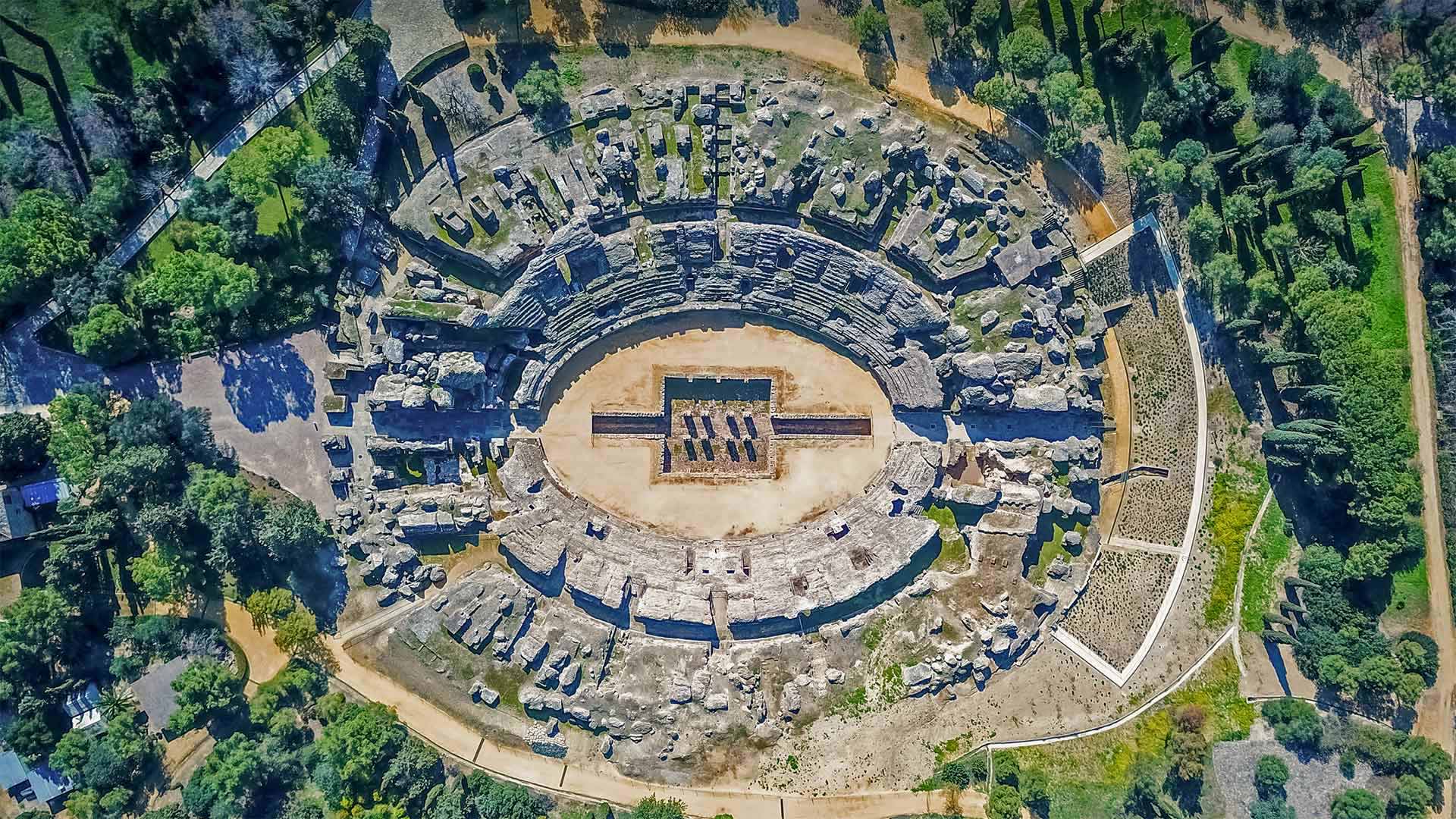
古罗马斗兽场,西班牙桑蒂蓬塞镇的罗马古城遗迹 The Roman amphitheater of Itálica near Santiponce, Spain (© Amazing Aerial Agency/Offset by Shutterstock)
Birthplace of Roman emperors
Just a few miles north of Seville, Spain, you'll find the ancient ruins of Itálica, the first Roman settlement in what is now Spain and the first Roman city outside of Italy. The city was founded in 206 BCE by the Roman general Scipio as a place to house veterans from the Second Punic Wars. Itálica was also the birthplace of at least two Roman emperors.
For centuries, Itálica was an elaborate urban center with a temple, a theater, public baths, gorgeous homes for the monied elite, and a population of about 8,000 residents. This aerial view is of the city's famous amphitheater, where thousands of spectators came from near and far to watch the bloody gladiator fights, hunts of wild beasts, and public executions. The 'entertainment' here was not for the faint of heart.
Today, the modern Spanish city of Santiponce has grown up around—and even atop—the ruins. Tourists come here to walk the preserved Roman streets, admire the mosaics, and imagine the scenes of life and death that happened in this amphitheater nearly 2,000 years ago.
罗马皇帝的出生地
在西班牙塞维利亚以北几英里的地方,你会发现古老的Itálica遗址,这是现在西班牙的第一个罗马定居点,也是意大利以外的第一个罗马城市。这座城市由罗马将军西皮奥于公元前206年建立,是第二次布匿战争退伍军人的住所。伊塔利卡也是至少两位罗马皇帝的出生地。
几个世纪以来,伊塔利卡一直是一个精心设计的城市中心,有寺庙、剧院、公共浴场、摩尼德精英的华丽家园,人口约8000人。这张鸟瞰图是该市著名的圆形剧场,数千名观众从四面八方赶来观看血腥的角斗士搏斗、野兽狩猎和公开处决。这里的“娱乐”不是为胆小鬼准备的。
今天,西班牙现代城市圣蒂蓬斯在废墟周围甚至在废墟上发展起来。游客们来到这里,是为了漫步保存完好的罗马街道,欣赏马赛克,想象2000年前发生在这个圆形剧场里的生死场景。
塔霍河上空的银河,西班牙蒙弗拉圭国家公园 Milky Way over the Tagus river in Monfragüe National Park, Spain (© Miguel Angel Muñoz Ruiz/Cavan Images)

塔霍河上空的银河,西班牙蒙弗拉圭国家公园 Milky Way over the Tagus river in Monfragüe National Park, Spain (© Miguel Angel Muñoz Ruiz/Cavan Images)
Celestial Spain
Today we're in the Extremadura region of western Spain, in the beautiful Monfragüe National Park along the border with Portugal. This 18-mile long, 4-mile wide stretch of nature in the province of Cáceres is framed by the Tagus and Tietar rivers (it's the Tagus that's in our image today). The mountainous Pena Falcon rock face defines its western side. Much of the park is covered by a thick Mediterranean forest full of wildlife, making this place a destination for outdoor lovers of all sorts. It's especially notable for the many birds: Over 280 species that are found here, including storks, kingfishers, cormorants, and eagles, as well as one of the world's largest reserves of black vultures and their tawny vulture cousins. Other wildlife routinely spotted in Monfragüe include otters, deer, wild boar, and Iberian lynx.
When the sun goes down in Monfragüe, the generally cloudless sky, combined with the low level of light pollution makes this a perfect place for stargazing. The national park was recognized as a dark-sky preserve in 2016. Monfragüe also appeals to those interested in the human history of the area, as it contains a number of caves with prehistoric paintings, Roman ruins, and the remnants of the castle of Monfragüe, which was built by Moors in the 9th century.
天国西班牙
今天我们来到西班牙西部的埃斯特马杜拉地区,在与葡萄牙接壤的美丽的蒙弗雷盖国家公园。这片18英里长、4英里宽的自然景观位于卡塞雷斯省,被塔格斯河和蒂塔尔河(我们今天的图像中就是塔格斯河)所环绕。多山的佩纳猎鹰岩面界定了它的西侧。公园的大部分被一片茂密的地中海森林所覆盖,森林里到处都是野生动物,这使这里成为各种户外爱好者的目的地。尤其值得注意的是,这里有280多种鸟类,包括鹳、翠鸟、鸬鹚和老鹰,以及世界上最大的黑秃鹫及其黄褐色秃鹫近亲保护区之一。其他经常在蒙弗雷盖发现的野生动物包括水獭、鹿、野猪和伊比利亚猞猁。
当太阳在蒙弗雷盖落山时,通常无云的天空,加上低水平的光污染,使这里成为一个完美的地方凝视星空。2016年,国家公园被认为是一个黑暗的天空保护区。蒙弗拉圭也吸引了那些对该地区的人类历史感兴趣的人,因为它包含了一些带有史前绘画的洞穴、罗马遗迹和蒙弗拉圭城堡的遗迹,蒙弗拉圭城堡是摩尔人在9世纪建造的。
由中世纪的城墙包围着的市镇,西班牙滨海托萨 The medieval walled town in Tossa de Mar, Catalonia, Spain (© dleiva/Alamy)
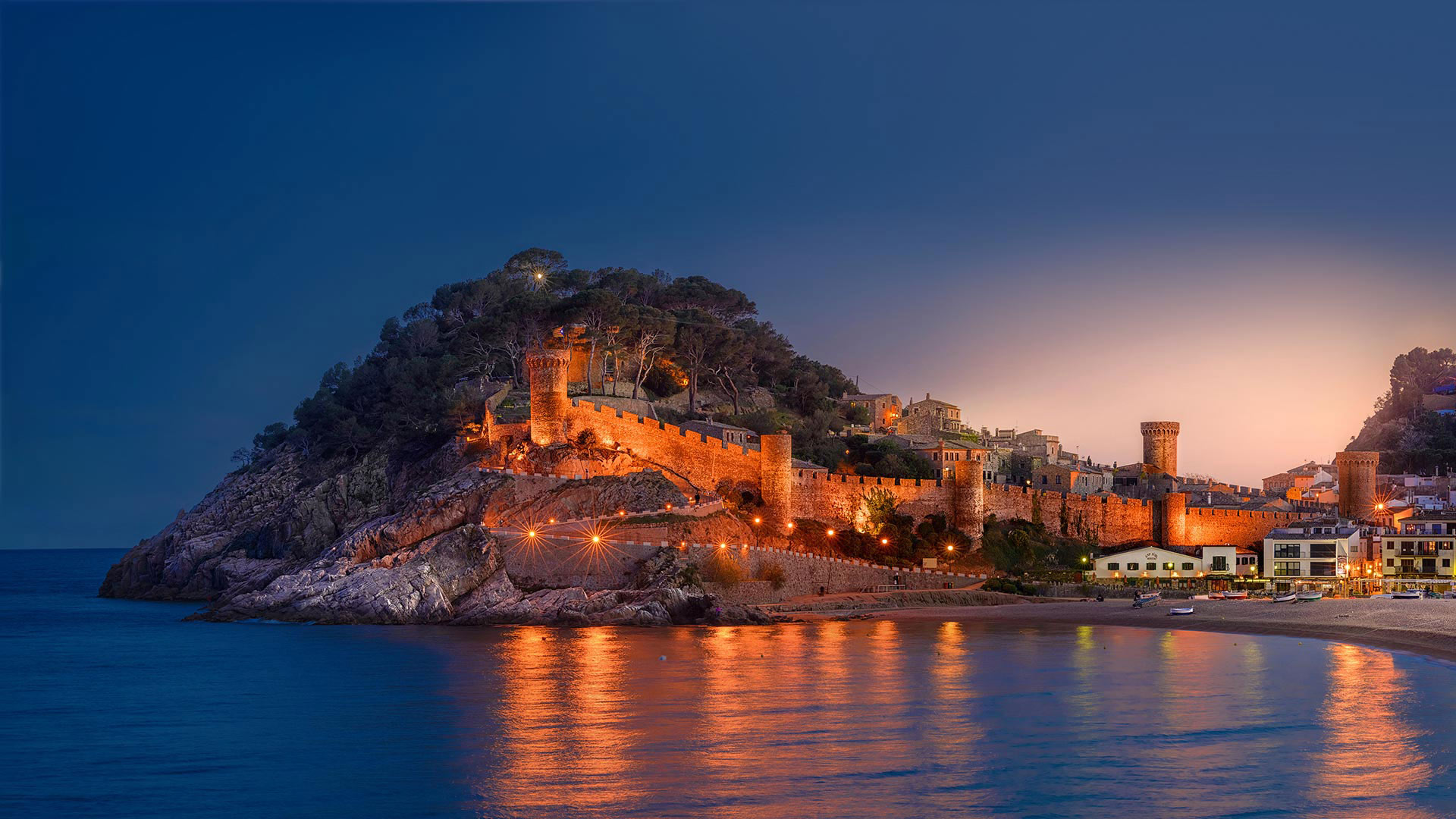
由中世纪的城墙包围着的市镇,西班牙滨海托萨 The medieval walled town in Tossa de Mar, Catalonia, Spain (© dleiva/Alamy)
Blue paradise on the Costa Brava
On Spain's Costa Brava, about 45 miles north of Barcelona, lies a perfectly preserved medieval town just beyond the enceinte (stone wall) you see curving up the hillside. La Vila Vella (The Old Town) blends with the more modern, larger city of Tossa de Mar. Here, the 21st century melds beautifully with the 14th.
Modern hotels are just out of the camera's viewfinder. Visitors can spend their days sunbathing on the beach, diving in the sea or strolling La Vila Vella's narrow, winding streets past centuries-old architecture. Just beyond the defensive walls is the deep blue sea. It was this view that inspired French painter Marc Chagall to nickname Tossa de Mar 'blue paradise.' In fact, Tossa de Mar has long been a haven for artists. Actress Ava Gardner loved the town so much while making two movies there in the '50s that the town has erected a statue in her memory.
布拉瓦海岸蓝色天堂
在西班牙的布拉瓦海岸,巴塞罗那以北大约45英里,坐落着一个保存完好的中世纪城镇,就在你看到的蜿蜒的山坡上。拉维拉维拉(老城区)与更现代化、更大的城市托萨德马尔融合在一起。在这里,21世纪与14世纪完美融合。
现代化的旅馆就在照相机的取景器外。游客可以在沙滩上晒日光浴,在海里潜水,或者漫步在拉维拉维拉的狭窄蜿蜒的街道上,这是一座古老的建筑。就在防御墙的后面是深蓝色的大海。正是这种观点启发了法国画家马克·夏加尔给托萨德马尔起了一个绰号“蓝色天堂”。事实上,托萨德马尔长期以来一直是艺术家的天堂。女演员艾娃·加德纳(Ava Gardner)在50年代拍摄两部电影时非常喜欢这个小镇,以至于小镇在她的记忆中竖起了一座雕像。
西班牙马拉加蓬皮杜中心 Centre Pompidou Málaga in Málaga, Spain (© Wim Wiskerke/Alamy)
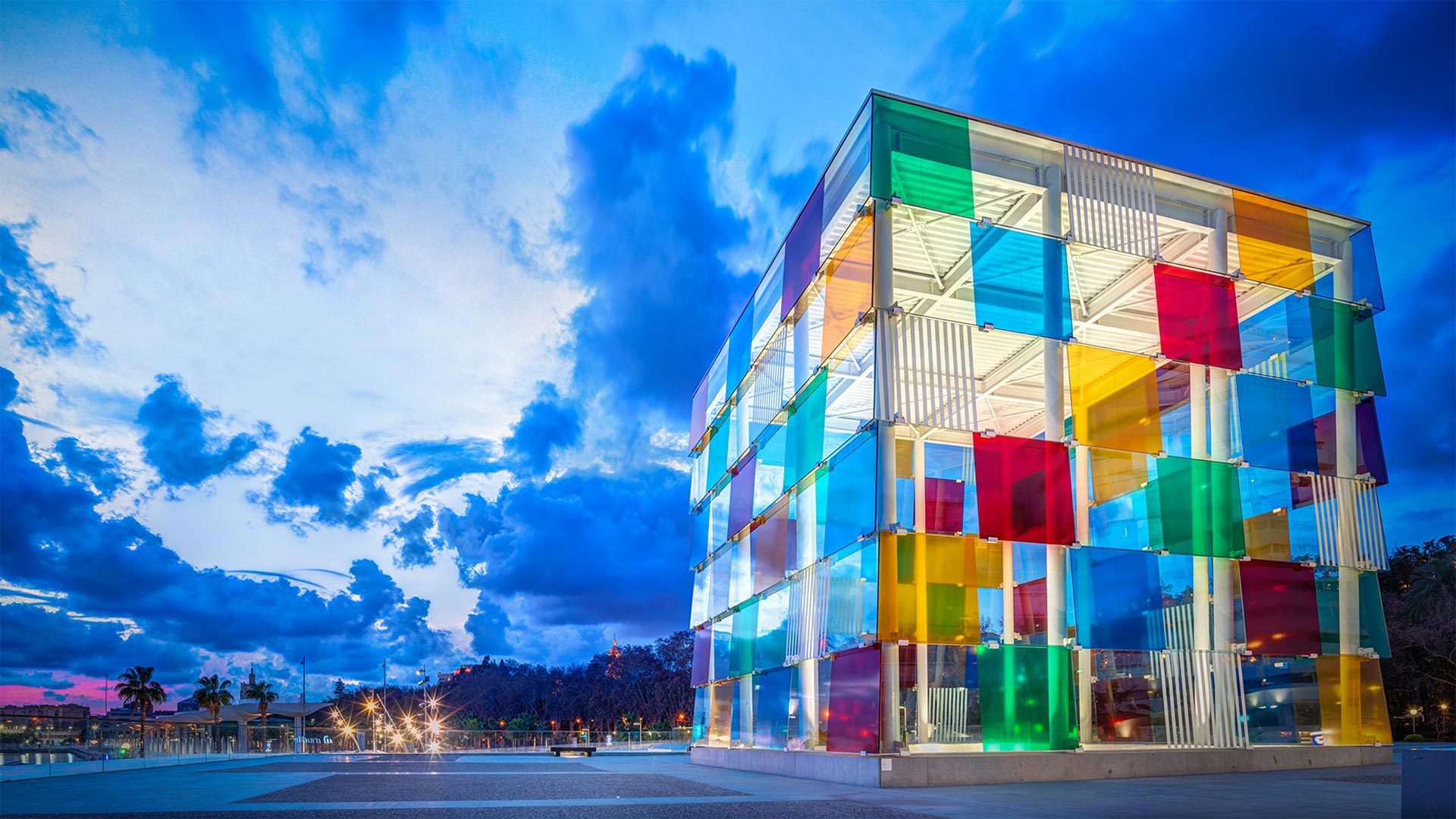
西班牙马拉加蓬皮杜中心 Centre Pompidou Málaga in Málaga, Spain (© Wim Wiskerke/Alamy)
International Museum Day
On International Museum Day, we're looking at the Centre Pompidou Málaga in Spain, an offshoot of the modern art museum in Paris. This location was introduced in 2015 as a pop-up branch—a temporary, underground space for exhibitions and multi-disciplinary experiences as well as workshops dedicated to younger audiences. Originally scheduled for a 5-year run, it was extended until 2025. The piece we see here, 'El Cubo,' created by French artist Daniel Buren, is the only part of the museum that's visible above ground. The glass cube functions as a multicolored skylight, its panels projecting tinted light into the subterranean museum's courtyard below.
International Museum Day began in 1977, with participating museums, galleries, and similar institutions offering free or reduced admission, as well as programs to highlight the work they do. In 2020, the format was adapted to focus on virtual activities, and this year will offer a mix of online, hybrid, and in-person events. As museums around the world begin to re-open their doors, this year's theme is 'The Future of Museums: Recover and Reimagine.'
国际博物馆日
在国际博物馆日,我们看到的是西班牙拉加蓬皮杜市中心,巴黎现代艺术博物馆的一个分支。2015年,这一位置作为一个弹出式分支引入,是一个临时地下空间,用于展览和多学科体验,以及专门为年轻观众举办的研讨会。原计划运行5年,延长至2025年。我们在这里看到的是法国艺术家丹尼尔·布伦(Daniel Buren)创作的“El Cubo”,这是博物馆中唯一能在地面上看到的部分。玻璃立方体的功能就像一个五颜六色的天窗,它的面板将有色光线投射到地下博物馆的庭院下面。
国际博物馆日始于1977年,参加活动的博物馆、美术馆和类似机构提供免费或减少门票,以及突出他们所做工作的项目。2020年,这种形式被调整为以虚拟活动为重点,今年将提供在线、混合和面对面的活动。随着世界各地的博物馆开始重新开放,今年的主题是“博物馆的未来:复原和重新想象”
菲格雷斯的达利剧院博物馆, 西班牙 Dalí Theatre-Museum in Figueres, Spain (© Valerija Polakovska/Shutterstock)
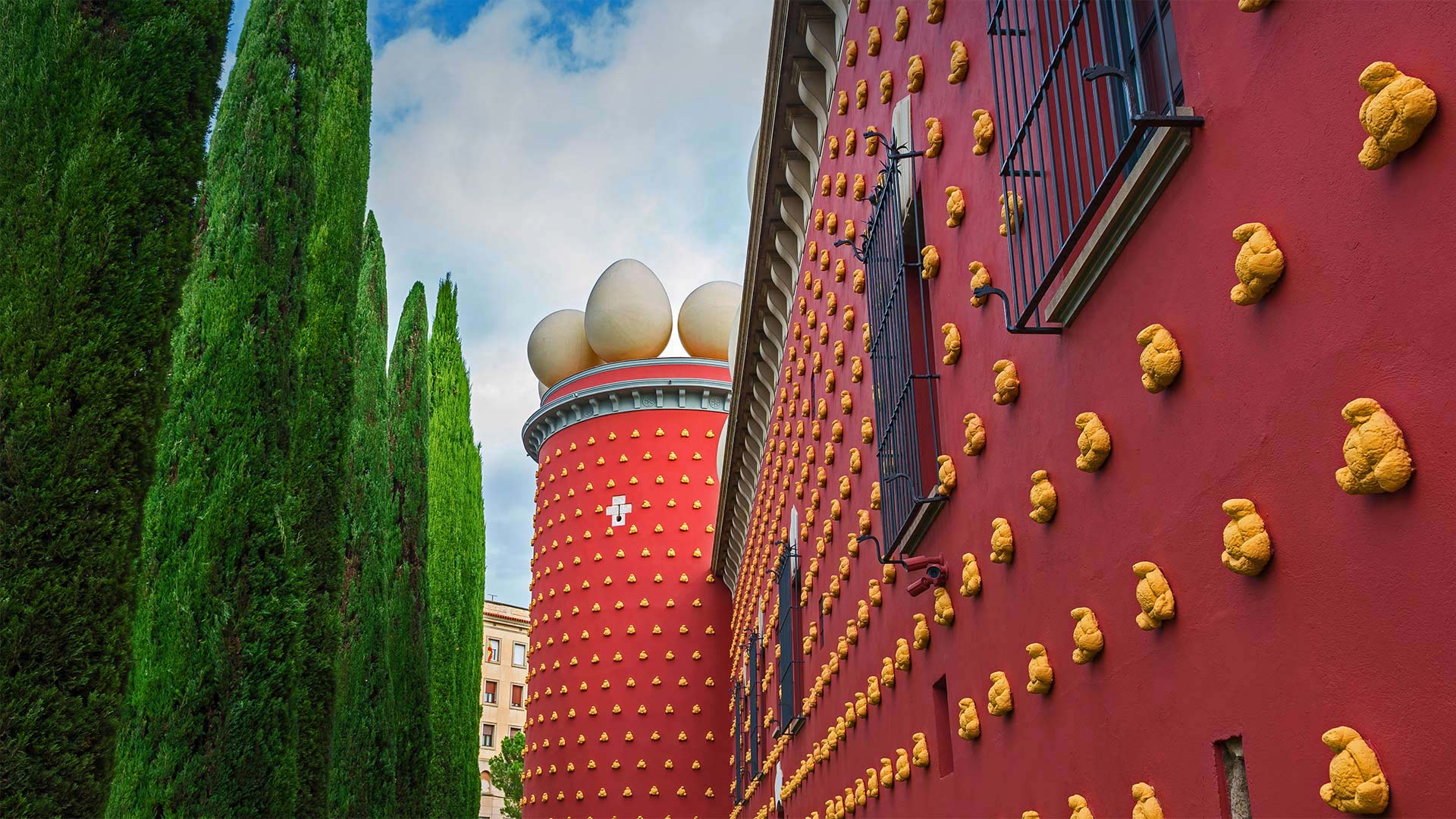
菲格雷斯的达利剧院博物馆, 西班牙 Dalí Theatre-Museum in Figueres, Spain (© Valerija Polakovska/Shutterstock)
'A theatrical dream'
The work of surrealist artist Salvador Dalí is the stuff of dreams: melting clocks, burning giraffes, weird objects suspended in midair. Gaze at a Dalí and you may find yourself gripped with a strange sense of familiarity, like your subconscious has visited these strange places before. But what if you could literally step into a huge Dalí piece?
This odd, ostentatious building in Dalí's hometown of Figueres, Spain, is exactly that. Fully imagined and designed by the artist himself, the Dalí Theatre-Museum is built on the ruins of the town's former municipal theater, where a precocious 14-year-old Dalí once had his first exhibition. 'The people who come to see it will leave with the sensation of having had a theatrical dream,' said Dalí, and his design delivered. The Theatre-Museum is a labyrinthine guided tour exploring Dalí's artistic growth and his wild ways of thinking—it features 1,500-plus Dalí originals from all stages of his career, as well as collected works by artists who inspired him. Some might even say it houses the specter of the great surrealist: Dalí himself is buried in a crypt below the building.
“戏剧梦”
超现实主义艺术家萨尔瓦多·达利的作品充满了梦想:融化的时钟、燃烧的长颈鹿、悬在半空中的怪异物体。凝视一个达利人,你可能会发现自己被一种奇怪的熟悉感紧紧抓住,就像你的潜意识以前去过这些奇怪的地方一样。但如果你真的能走进一个巨大的达利片呢?
达利家乡西班牙菲格雷斯(Figueres)的这座奇特、招摇的建筑正是如此。达利剧院博物馆完全是由艺术家自己想象和设计的,它建在该镇前市政剧院的废墟上,一个早熟的14岁的达利曾经在那里举办过他的第一次展览达利说,前来观看的人会带着做了一个戏剧梦的感觉离开,他的设计交付了。剧院博物馆是一个迷宫式的导游之旅,探索达利的艺术成长和他狂野的思维方式。它展出了1500多件达利在其职业生涯各个阶段的原作,以及激发他灵感的艺术家收集的作品。有人甚至会说,这里藏有伟大超现实主义的幽灵:达利本人被埋在大楼下面的一个地下室里。
力拓河中含矿物质的水,西班牙里奥廷托矿区 Mineral-laden water in the Rio Tinto in Minas de Rio Tinto mining area, Huelva province, Andalusia, Spain (© David Santiago Garcia/Getty Images)
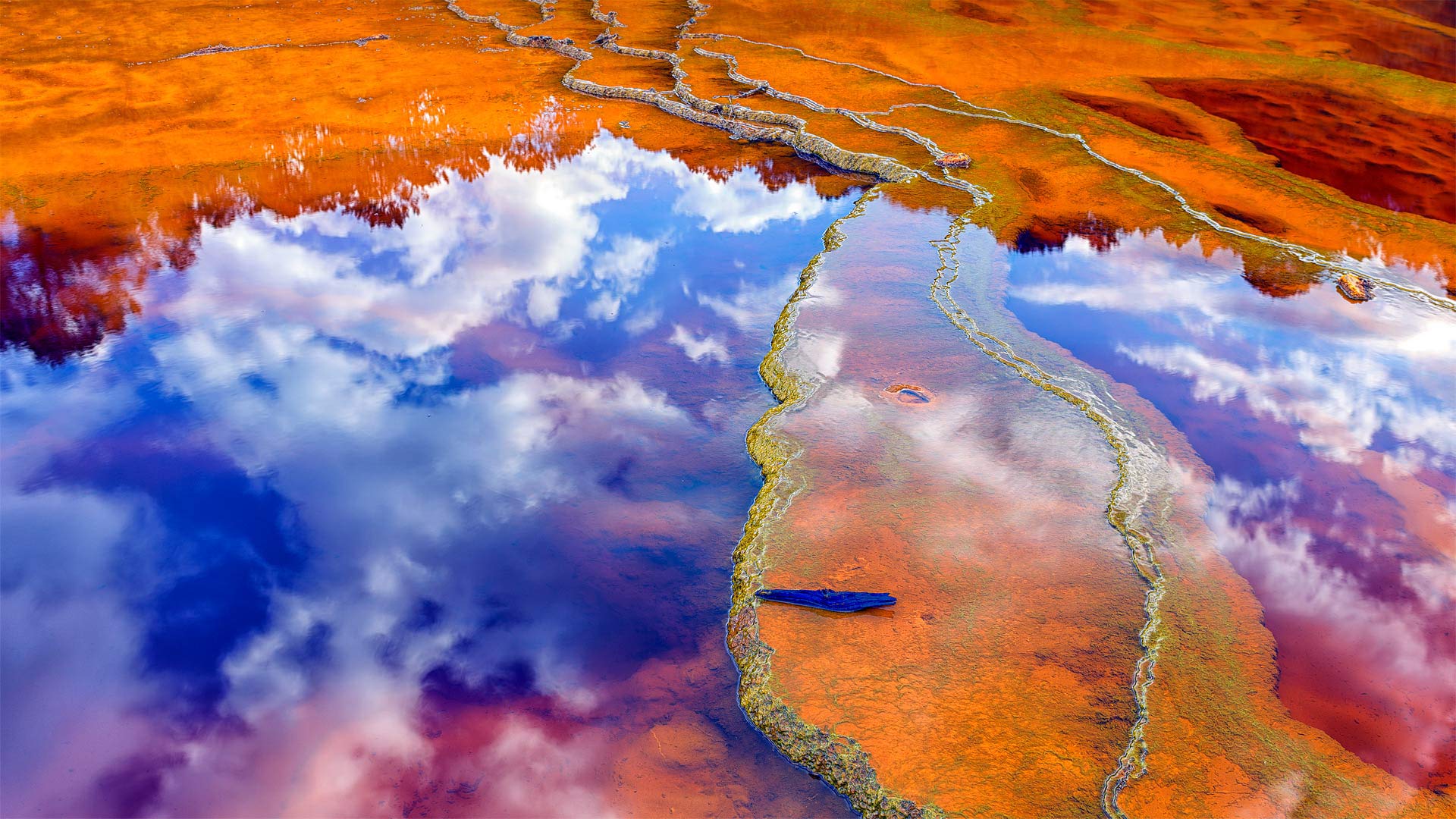
力拓河中含矿物质的水,西班牙里奥廷托矿区 Mineral-laden water in the Rio Tinto in Minas de Rio Tinto mining area, Huelva province, Andalusia, Spain (© David Santiago Garcia/Getty Images)
Reflecting on one of the world's strangest rivers
If you like your landscapes on the surreal side, then this weird and wonderful river in the Andalusia region of southwestern Spain should be to your liking. The Rio Tinto (Red River) gets its name from the reddish hue of its water, which contains high levels of iron and sulfur, making it very acidic. This unusual chemical makeup may or may not be a result of the area's long history of mining, which dates back at least 5,000 years. Ancient residents like the Tartessians and Romans dug for copper, silver, gold, as well as the mineral pyrite, commonly referred to as 'fool's gold.' Legend has it that Rio Tinto was the site of the fabled mines of King Solomon.
Because of its extreme acidity, the river and surrounding areas are not only colorful, but also quite different than any other in Spain, with a scarcity of normal plant life in and along the riverbeds. Only a thriving community of unusual microorganisms—classified as extremophiles—can survive the water's acidic mix, by feeding on the minerals alone. The strangeness of Rio Tinto's ecology has even attracted the attention of NASA, which studied the bacteria that have adapted to this highly acidic environment because the conditions resemble those on the surface of Mars.
回想世界上最奇怪的河流之一
如果你喜欢超现实主义的风景,那么这条位于西班牙西南部安达卢西亚地区的奇怪而奇妙的河流应该是你喜欢的。力拓(Rio Tinto,红河)因其水呈微红色而得名,水中含有大量的铁和硫,使其呈酸性。这种不寻常的化学成分可能是也可能不是该地区悠久的采矿历史的结果,至少可以追溯到5000年前。像鞑靼人和罗马人这样的古代居民挖掘铜、银、金,以及通常被称为“傻瓜金”的黄铁矿。传说力拓是传说中所罗门王的矿山所在地。
由于其极端的酸度,这条河及其周围地区不仅色彩丰富,而且与西班牙的任何其他地区都有很大的不同,河床内和沿岸缺乏正常的植物生活。只有被归类为极端微生物的不寻常微生物群落才能在水的酸性混合物中存活下来,仅以矿物质为食。力拓公司生态的奇特甚至引起了美国宇航局的注意,该局研究了适应这种高酸性环境的细菌,因为这种环境与火星表面的环境相似。